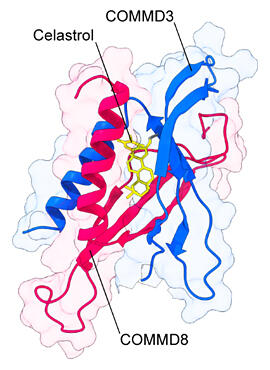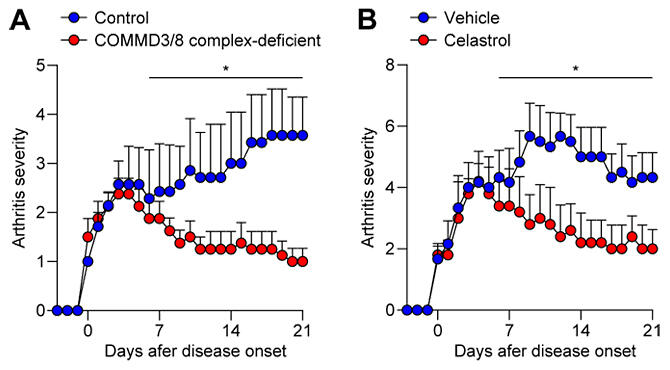A research team led by Professor Kazuhiro Suzuki and Research Fellow Taiichiro Shirai at the Osaka University Immunology Frontier Research Center (IFReC) discovered an immune regulatory factor, the copper metabolism MURR1 domain‐containing (COMMD) 3 and 8 (COMMD3/8) complex, to be involved in the pathological exacerbation (i.e., development and progression) of autoimmune diseases. Additionally, the team identified celastrol, a compound that inhibits the functions of the COMMD3/8 complex and demonstrated the potential of the COMMD3/8 complex as a new therapeutic target for autoimmune diseases. Suzuki explained, "Although celastrol does not appear to have major side effects in mice, we are conducting a study in collaboration with pharmaceutical companies to develop a low‐molecular‐weight compound that is more suitable for human use." These findings were published in Science Immunology.

Credit: © 2023 Shirai et al., Science Immunology
The COMMD3/8 complex was identified by the research group as a chemokine receptor signaling molecule that regulates immune cell migration and is composed of the proteins COMMD3 and COMMD8. The group has previously shown that this complex plays an important role in B lymphocyte migration and the humoral immune response.
According to Suzuki, "The COMMD3/8 complex plays an important role in the induction of autoimmunity", so the team focused on rheumatoid arthritis, an autoimmune disease that affects a large number of patients. Various mechanisms are involved in the progression of rheumatoid arthritis, one of which is that autoantibodies produced by B cell‐mediated immune responses are known to aggravate the disease.
Deletion of the COMMD3/8 complex in a mouse model of rheumatoid arthritis reduced the production of autoantibodies and the progression of the disease. Since the COMMD3/8 complex was found to be involved in the progression of rheumatoid arthritis, the team searched for a compound that could suppress the function of the complex and identified celastrol. Celastrol is a major medicinal extract from an anti‐inflammatory medicinal herb known as the "Thunder God Vine," but the mechanism of its pharmacological action was not fully understood.
Administration of celastrol to a mouse model of rheumatoid arthritis resulted in effects similar to those that occurred in the mice deficient in the COMMD3/8 complex. Through molecular dynamics simulations and mass spectrometry, the group found that celastrol covalently binds to the 170th cysteine of COMMD3, thereby inhibiting its complex formation with COMMD8. "Both COMMD3 and COMMD8 cannot exist as single entities, because they are decomposed immediately," added Suzuki.

Credit: © 2023 Shirai et al., Science Immunology
Most interestingly, although celastrol inhibits the functions of B lymphocytes, it does not affect T lymphocytes and other cells. The immunosuppressants used for treating autoimmune diseases have severe side effects because they prevent the activity of the immune system. "Celastrol could be a therapeutic drug that does not cause overall immunosuppression," Suzuki continued, "Furthermore, if a low‐molecular‐weight drug using celastrol as the lead compound can be developed, it would yield health economic benefits."
This article has been translated by JST with permission from The Science News Ltd. (https://sci-news.co.jp/). Unauthorized reproduction of the article and photographs is prohibited.




